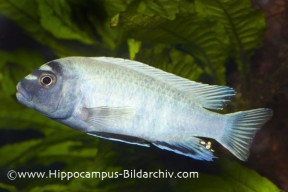Pseudotropheus elongatus
Elongate Mbuna
Classification
Cichlidae
Distribution
Endemic to Lake Malawi. It is found in Mbamba Bay and Nkata Bay.
Habitat
It inhabits shallow water in rocky areas, commonly being found in association with small rocks. Its habitats are characterised by having little or no sediment.
Maximum Standard Length
Males to 5.4″ (13.5cm), females to 4″ (10cm).
Aquarium SizeTop ↑
48″ x 15″ x 12″ (120cm x 37.5cm x 30cm) – 135 litres.
Maintenance
Use piles of rocks to form cave-like structures and hiding places, leaving areas of open water for swimming. A substrate of sand is preferable. Algal growth should not be discouraged.
Water Conditions
Temperature: 75-82°F (24-28°C)
pH: 7.6-8.8
Hardness: 10-25°H
Diet
It will accept most foods offered but vegetable matter in the form of spirulina flakes, blanched spinach, nori etc. should form a large proportion of the diet. This can be supplemented with live and frozen varieties. Never feed beefheart or any other red meat as it interferes with the digestive system of these fish.
Behaviour and CompatibilityTop ↑
One of the most aggressive and territorial mbuna. It should not be kept with peace loving species such as Peacocks or Utaka but it can be combined with other mbuna provided they do not resemble it in patterning. The tank should be overcrowded to reduce aggression and territory formation. It is incredibly aggressive towards others of the same species and the presence of heterospecifics helps to dissipate this. However a very large tank is required in order to keep more than one male and even then it is likely that the sub-dominant male(s) will be killed. At least 4-6 females should be kept per male for their own safety!
Sexual Dimorphism
Adult males are usually larger and have brighter egg spots on the anal fin than females.
Reproduction
Possible but not easy. Maternal mouthbrooder. It should be spawned in a species tank in a harem of one male and at least 4-6 females. A 48″ aquarium is a good size (although larger is preferable) and this should be furnished as suggested above, along with some flat stones and areas of open substrate to act as potential spawning sites. Make sure plenty of hiding places are provided as the male may kill females that are not ready to spawn. The pH should be around 8.2-8.5 and the temperature 77-80°F. The fish should be conditioned with plenty of live and frozen foods.
The male fish will clean and then display around his chosen spawning site, showing intense colour, and attempt to entice females to mate with him. He is very aggressive in his pursuits and it is in order to dissipate this aggression that we spawn this species in a harem. When a female is willing, she will approach the spawning site and lay her eggs there, after which she picks them up in her mouth.
The male fish has egg-shaped spots on his anal and the female is attracted to these. When she tries to add them to the brood in her mouth she actually recieves milt from the male, thus fertilising the eggs.
The female will carry the eggs for around 3-4 weeks before releasing the free swimming fry. She will not eat during this period and can be easily spotted by her distended mouth. If a female is overly stressed she may spit out the brood prematurely or eat them, so care must be taken if you decide to move the fish in order to avoid fry predation or harassment by the males. However we do recommend that holding females are removed, as the male will usually not leave them alone. Some breeders artificially strip the fry from the mother’s mouth at the 2 week stage and raise them from that point as this usually results in a larger number of fry.
The fry are large enough to take brine shrimp nauplii from birth. If they are left with the mother she will actively protect them for a few days after which they are permitted to remain in her territory.
NotesTop ↑
Over 30 different forms of this species occur in Lake Malawi. These should not be mixed in the aquarium as they will hybridise freely. P. elongatus differs morphologically from other mbuna, being relatively slender and elongate. In nature females protect territories which contain ‘gardens’ of algae which they leave to breed before returning once they are holding eggs. Juvenile fish from previous spawns also inhabit the territory, protecting it when the female is away.
This species is not recommended for the beginner due to it’s violent nature, but does make a good aquarium subject for the advanced aquarist.



